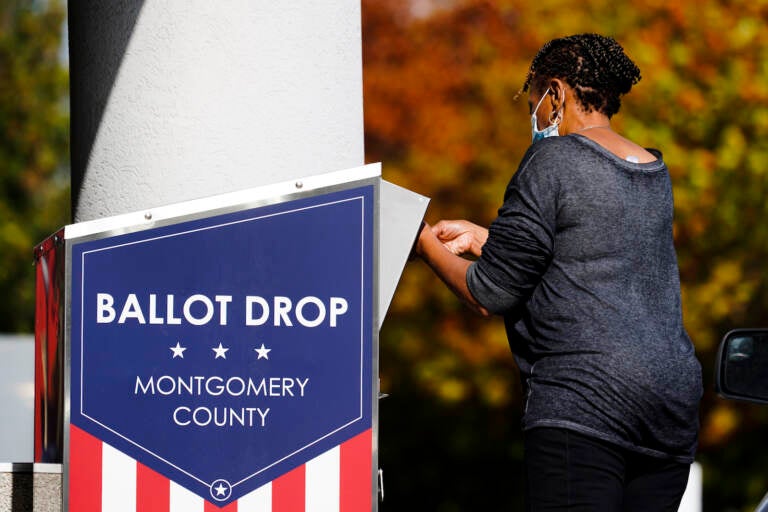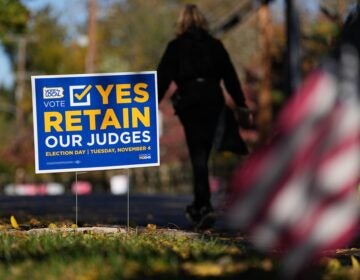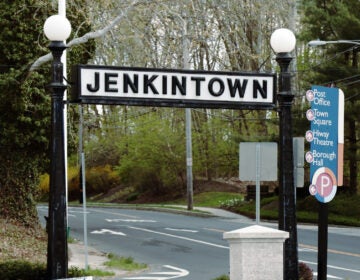For Pa.’s statewide candidates, 2021 lessons are in the eye of the beholder
Takeaways often had more to do with candidates’ existing campaign strategies, rather than sober analysis of electoral trends.

A person drops off a mail-in ballot at an election ballot return box in Willow Grove, Pa., Monday, Oct. 25, 2021. (AP Photo/Matt Rourke)
Pennsylvania politicians running in statewide 2022 races all took lessons from this week’s election, which saw Republicans dominate the statewide races on the ballot and rack up strong showings in other states.
But those lessons varied, and — as in most campaign messaging — often had more to do with candidates’ existing campaign strategies than sober analysis of electoral trends.
In general, the 2021 election was characterized in Pennsylvania by relatively strong overall turnout for an odd-year election. As of Friday, the vote-count in the top-ticket race, for Supreme Court, was nearly 30% percent higher than in 2017, the last municipal year in which a Supreme Court seat topped the ballot directly after a presidential election.
Also notable were performance trends compared with Joe Biden’s 2020 Pennsylvania victory. Although turnout was dramatically lower compared to the general election, the winning Supreme Court candidate, Republican Kevin Brobson, generally underperformed Trump’s victory share in the more rural counties in western Pa., but did better than the former president in the hugely populous Philadelphia suburbs.
Biden had won both Montgomery and Delaware Counties by about 27 points, Chester by about 17 points, and Bucks by about five points. Democratic Supreme Court candidate Maria McLaughlin won Montgomery County by 18 points and Delaware and Chester by eight and six points, respectively. She lost Bucks County by a little less than three points.
Candidates read the tea leaves
John Fetterman, the lieutenant governor and former small-town mayor seeking the Democratic nomination for U.S. Senate, was looking at those rural counties, and also south to Virginia, where Republican Glenn Youngkin beat Democrat Terry McAuliffe in a state President Joe Biden won easily last year.
“If we learned anything last night, it’s that Democrats can’t continue to completely cede
rural counties to Republicans,” Fetterman’s campaign wrote in an internal memo on Wednesday. “Last night showed that margins matter, even in counties that Democrats are never going to win. When you cede county after county to Republicans, that is a losing strategy.”
It’s an against-the-grain argument in a state where the post-2020 consensus was that while Joe Biden had improved on Democrats’ 2016 performance in rural areas, his real strength had come from massive margins in the suburbs.
The rest of Fetterman’s Democratic opponents stuck to more conventional wisdom in their 2021 post mortems.
Montgomery County Commissioner Val Arkoosh issued a statement arguing that the results — which saw Youngkin do far better in blue suburbs than Donald Trump — show that “suburban voters continue to wield incredible political power in statewide elections.”
“To win the open U.S. Senate seat in 2022, it is critical that Democrats nominate a candidate with a base in Philadelphia’s vote-rich suburbs and a track record of appealing to suburban voters and taking action on their behalf,” campaign staff wrote. “That’s Val Arkoosh.”
Conor Lamb, the moderate Democratic congressman from the Pittsburgh suburbs, stressed similar bona fides in a phone conversation with Keystone Crossroads between House votes. He said the Democratic loss in Virginia and a closer-than-expected race in New Jersey show that “you can’t assume the suburbs in particular are going to be part of the Democratic coalition every time.”
Philadelphia State Rep. Malcolm Kenyatta added he’s particularly focused on turnout in his home city. It’s typically dismal in odd-year elections, and 2021 was no exception. With some ballots still to be counted on Friday, it appeared that less than 20% of registered voters in Philly had cast votes.
“Democrats can’t win statewide with turnout like that,” he said. “It’s going to be vitally important that we nominate … working class candidates who can speak to those working class voters, which still make up our party, of all different races, backgrounds and regions.”
Republican gubernatorial candidate Lou Barletta, the former Hazleton mayor and congressman who ran unsuccessfully for U.S. Senate in 2018, also looked to the suburbs. A campaign spokesman issued a statement that referenced school board races that were contentious throughout the state, especially in suburban districts.
“Voters think government has gotten out of control and want it reined in,” spokesman Tim Murtaugh wrote in an email. “It’s also crystal clear that parents have the right to be involved in their children’s education. These messages from Tuesday reflect what Lou Barletta hears on the campaign trail every day and will be very important in the Pennsylvania election of 2022.”
Carla Sands, a Trump ally and prodigious self-funder running for U.S. Senate, added through a spokesperson that Pennsylvania Republicans’ victories, “tied with Governor-elect Youngkin’s win last night, signals that a red tsunami is moving across our great country.”
‘Very narrowly balanced’
Lara Putnam, a historian at the University of Pittsburgh who studies the growth of local political networks, says she thinks some of the lessons politicians and pundits seem to be taking from Virginia and New Jersey elections are off base — and that they have limited relevance to Pennsylvania, anyway.
“I’m seeing a lot of commentariat takes about how results in Virginia and New Jersey show a sort of sea change in suburban politics or statewide politics,” she said. “Reactions that say, ‘Wow, you know, efforts by progressives to be more attentive to issues of race and equity caused a huge backlash among white people everywhere, this is going to be Democrats’ doom.’”
While some pundits have offered that take in regards to Virginia, a Keystone Crossroads analysis of school board races in the Philly suburbs found that results largely rested on an area’s existing partisan tilt. Evidence doesn’t suggest these issues spurred new voting patterns writ large.
Putnam also points out that the closest statewide race in Pennsylvania was between Commonwealth Court candidates Drew Crompton and Lori Dumas — respectively a white Republican and a Black Democrat. Black women also won several school board and mayoral races in predominantly white communities.
She says while this doesn’t say anything conclusive about voters’ attitudes toward race, it’s a data point. “There’s been an openness from the electorate to elect more diverse candidates,” she said, noting that she’s seen some of that openness in the GOP, too. Virginia, for instance, elected its first Black lieutenant governor, a Republican.
Mike Barley, a GOP strategist who works for Harrisburg lobbying firm Long Nyquist, says he’s also primarily watching in-state races for clues about 2022.
In general, he says, it’s always “a harbinger of good” for Republicans when their judicial candidates do well — though there are exceptions. A Republican won the 2017 Pa. Supreme Court race, but the party ended up losing many key 2018 contests.
Perhaps more instructive, Barley said, are the dynamics he saw in school board races. Unlike Putnam, he thinks local uproar over whether critical race theory was being taught in classrooms could translate to electoral trends beyond school boards — as could general discontent over how schools handled COVID-19 safety.
“There’s certainly a number of folks that stood up, parents, who vehemently disagreed with the thought that teachers and administrators and others should be in charge of their child’s education,” he said. “They don’t like a curriculum that forces, you know, children to look at things through a prism of race.”
Mustafa Rashed, a Democratic operative with the Harrisburg government relations firm Bellevue Strategies, is thinking about where Democrats’ messaging broke down, both in Pennsylvania and in Virginia. Democratic candidates in those races generally tended to invoke Trump as a symbol for the GOP as a foil to oppose.
“Running against Trump is no longer a winnable strategy,” Rashed said. “One of the things we saw since 2016 is that candidates from the school board level all the way up to the United States Senate … ran sort of as opposition to former President Trump. And at this point, with [Democrats in control of the White House and the House and Senate], they need to be able to show what their vision is for America.”
He added that 2021 saw Republicans do a good job “turn[ing] out their base by using social issues.” He thinks Democrats, in turn, must be able to point to tangible accomplishments.
“I think they’re going to have to talk about economic issues, how they get the economy going and moving forward, what the post-pandemic world looks like,” he said. “For Americans, that’s what it has to be. It can’t be looking backwards.”
Putnam says ultimately, she thinks 2021 has shown that Pennsylvania is a state largely controlled by factions, in many cases down to the most local levels of government. She, too, is thinking a lot about school boards, which she watched closely in this year’s races.
Even in the largely blue Philadelphia suburbs, she says, they split many communities sharply down partisan lines.
“Especially in the suburban areas that had been pretty traditionally Republican and then had been moving in the democratic direction … things have been kind of battled to a halt,” she said. “So it’s not that there hasn’t been a rolling back of democratic advances in those places on school boards, but there has been pushback and a lot of intense feelings on all sides.”
In a way, she said, it’s a microcosm of the whole commonwealth.
“It’s just very narrowly balanced,” she said.

Get daily updates from WHYY News!
WHYY is your source for fact-based, in-depth journalism and information. As a nonprofit organization, we rely on financial support from readers like you. Please give today.







